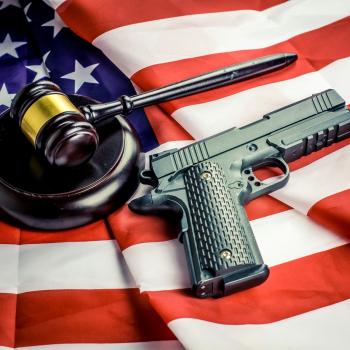Dick “Don’t Let the Door Hit Ya” Cheney made headlines yesterday after he made a joke at the expense of West Virginians in front of the National Press Club, a joke centering around the oh-so original image of Appalachian incest. West Virginia’s Democratic governor Joe Manchin promptly slammed Cheney for disrespecting his state and his people, demanding an apology — funny, coming from a politician whose eerily Republican policies have done more harm to West Virginians than any demeaning joke ever could.
But Cheney’s joke — and subsequent apology — is but the latest in a recent string of demeaning references to Appalachia in the media, set off by Hillary Clinton’s recent victories in Appalachian states such as West Virginia and Kentucky. The Appalachian Front Porch blog focused recently on the way the media — especially the so-called “progressive” media such as Jon Stewart, Grist, and the New York Times — reacted to Obama’s “Appalachia problem.”
But c’mon — Jeff Foxworthy, Jon Stewart, Dick Cheney — they’re all just making harmless jokes, right?
Wrong.
Appalachian stereotyping, like all stereotyping, is not harmless. Regardless of whether or not Appalachian stereotypes correspond to reality (most, of course, do not), Appalachian scholars have shown how images of the region function socially and politically as expressions of power and superiority, rendering an entire people inferior and thus worthy of exploitation. Coinciding with the physical colonization of the region through resource extraction and industry was the invention of Appalachia as a distinct region within the United States. Since the 1970’s, numerous studies have examined the development of the idea of Appalachia and how this idea functioned in post-Civil War American society. Allen Batteau, for example, writes:
The image of Appalachia as a strange land and peculiar people was elaborated at the very same time that the relationships of external domination and control of the Southern Mountain Region’s natural and human resources were being elaborated…. For better or worse… the imagery of Appalachia and the social forms of its propagation are implicated in federal policy and the stance that public and private social agencies have taken toward the region…. Appalachia — read-about Appalachia, personally experienced Appalachia, laughed-at Appalachia, inspired-by Appalachia — is just as much a social construction as the cowboy or, for that matter, the Indian. This invention was accomplished not in a professor’s study but in the hurly-burly of politics and commerce and industry. And further, it was pursued with some very specific political ends in view.
Most Appalachian scholars locate the origin of the idea of Appalachia within various literary narratives, particularly the popular postbellum “local color” writers who constructed fiction centering around the curiosities of regional cultures which helped to define middle class American values by creating and gazing at exotic “others.” As has been the experience of other colonized peoples, a number of scholars have noted that the creation of a distinct, homogeneous region called Appalachia, as well as its colonization, was also facilitated by the missionary activity of the churches after the Civil War, who spread the political ideologies and values of middle class America to the people they served.
Take William Frost, for example, a missionary and president of Kentucky’s Berea College from 1892-1920. In the face of dwindling enrollment and funding upon taking office, Frost actively recruited students and money with speaking tours highlighting Berea College’s mission to mountain people whom he called “our contemporary ancestors,” and “belated Americans” who had fallen into a “Rip Van Winkle sleep.” In the process, he appealed to the mountain people’s ties to colonial America as well as their ethnic purity, claiming that the region was free of foreign immigrants, and he became the first to name the region, calling it “one of God’s grand divisions, and in default of any other name we shall call it Appalachian America.” According to Batteau, many of the most vivid images of Appalachia come from the efforts of figures like Frost, “that of Appalachia as a region behind the times that needs help catching up, that of Appalachians as a wilderness ‘folk,’ and the image of Appalachia as a suitable expanse for pioneering.”
Despite the complex sources and forces that contributed to the development of the image or idea of Appalachia, what developed, and continues to exist today, is a two-sided and contradictory image of Appalachians: that of a romanticized proud people steeped in tradition and “original” American values, or its opposite, a culture of backward, ignorant, and violent savages. Both images have been intimately related to definitions of mainstream American middle-class values, either by providing sentimentalized, inspiring images of the nation’s origins, or by presenting an image of the boundaries of civilization. In his 1987 book Apples on the Flood: Minority Discourse and Appalachia, Appalachianist Rodger Cunningham connects many of the loose threads described above, such as Frost’s “discovery” of Appalachia, early missionary activity, and economic exploitation and reads them in light of the United States’ colonization and extermination of indigenous peoples. Cunningham suggests that the “dynamic of ‘American’ character” requires a frontier to be conquered, and with the increasing extermination and displacement of Indian peoples, he says “‘America’ was on the lookout for another barbarism to subdue.”
In the course of his argument, Cunningham points to two statements made about two different groups in Appalachia: Indians and mountain people. The first is a quote from an 1818 House Committee on Indian Affairs report:
In the present state of our country one of two things seem to be necessary, either that these sons of the forest should be moralized or exterminated.
A Virginia newspaper editorial, about a century later, read:
The majority of mountain people are unprincipled ruffians. . . . There are two remedies only — education or extermination. Mountaineers, like the red Indian, must learn this lesson.
As part of the Appalachian-as-savage myth, the “inbred white trash” stereotype emerged around this time, positing that Appalachian “poor whites” were set apart from other whites as a result of genetic deficiencies caused by inbreeding or race-mixing. Indeed, “poor, lazy hillbilly whites” were included in the well-known eugenics projects in the United States just as Native people were. Contemporary forms of inbreeding jokes and “white trash” humor are every bit as racial and political as these earlier patterns of thought. Then and now, the term “white trash” designates a white person who has crossed the boundary of acceptable characteristics or behavior for “being white.” The notion of “white trash” combines racism and classism into one pejorative term that is insulting to the person being ridiculed, but which is also inherently racist in its insinuation that “only people who are not white act that way.” “White trash” humor says that there is a standard for “whiteness” that must not be crossed.
Whether ridiculed as the inbred barbarian or romanticized as the “contemporary ancestor” — the result is the same: Appalachians become dehumanized, childlike “others,” spoken for by the dominant culture, who as Cunningham says, “can fulfill their destiny only by becoming essentially like the obvserver.” Even in the case of the idealized, traditional pioneer, Cunningham says, “sentimentalism only replaces the injunction ‘Grow up!’ with the injunction ‘Do not grow up!’—and both injunctions are equally false to the subject’s real maturity and integrity.”
And just as Appalachian stereotypes developed in tandem with the beginnings of economic exploitation in the region, the same stereotypes continue to serve the interests of capitalism and U.S. political and cultural imperialism. Appalachian politicians such as WV’s Governor Manchin “sell” Appalachian poverty to outside companies by advertising the region’s low wages, “docile” work force, low unionization rates, etc. The “throw away people” of Appalachia also continue to bear the burden of environmental injustice such as the ongoing practice of mountaintop removal mining, all for the “common good” of America’s energy needs.
And not only are a disproportionate number of Appalachian bodies exploited, generation after generation, to serve in the U.S. military, Appalachian stereotypes are invoked as part of the mythological narratives that drive U.S. imperialism, especially the War on Terror, as Carol Mason demonstrated in a recent journal article. Mason provides a fascinating analysis of two female soldiers from West Virginia, Jessica Lynch and Lynndie England, who made headlines over the last few years and who embodied the two contradictory hillbilly images we referred to earlier, Lynch representing the good country girl rescued from barbaric Iraqis, and England representing the barbaric savage who was photographed torturing Iraqi prisoners at Abu Ghraib. Attending to the role of class, gender, and race in the two stories, Mason showed how each used Appalachian hillbilly stereotypes either to inspire support for the war on terror or to explain away U.S. torture tactics by blaming them on a “gender-bending hillbilly.”
In light of the connections between “harmless” Appalachian stereotypes and economic exploitation in the region, we should not be surprised by Cheney’s remarks. His obviously dehumanizing view of Appalachians fits well with his administration’s policies which are animated by a contempt for “throw away people” of all sorts, all over the globe. While the internal colonization of Appalachia continues, Cheney’s heartless parroting of Appalachian stereotypes reveals the continuation of the American imperial logic that colonizes peoples both foreign and domestic. In the minds of many Americans — and of one of America’s chief imperial architects — Appalachians continue to be one of America’s strange “others”: “trash” to be exploited in the service of capital, bodies to be mobilized in defense of a self-centered way of life, and scapegoats to point to when America’s dysfunctional tendencies come back to haunt it.












